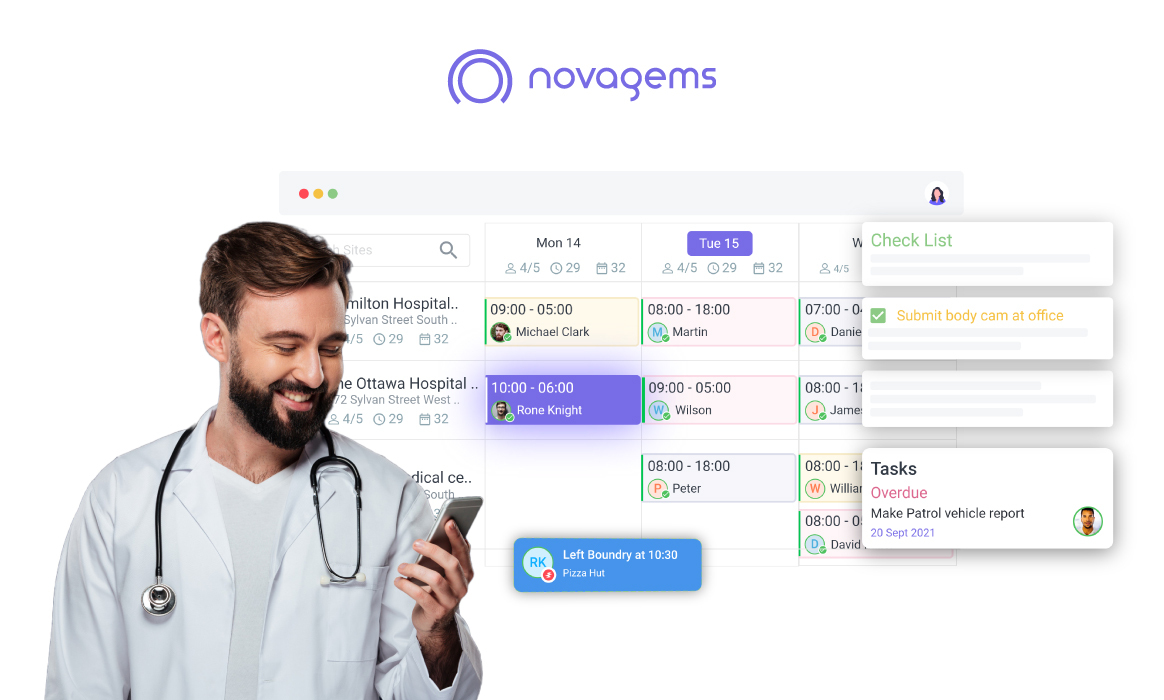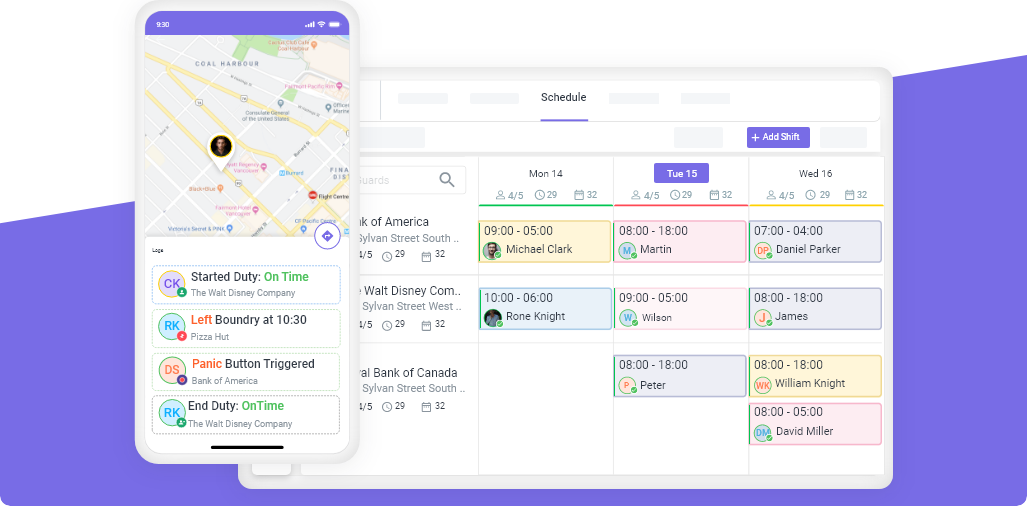Healthcare Staff Scheduling Issues & How to Solve Them
Sun, May 5, 2024
Read in 9 minutes

In the healthcare industry, making sure staff schedules are well-organized is very important. Proper scheduling ensures that patients receive the best care and healthcare professionals are not overworked. However, many issues can make scheduling a challenging task. If Staff Scheduling Issues are not addressed on time, it can create a big issue in future. This blog will explore why healthcare staff scheduling matters, common issues faced, and effective solutions to overcome these challenges.
Why Healthcare Staff Scheduling Matters
Healthcare staff scheduling is not just about filling shifts. It directly impacts the quality of patient care, staff satisfaction, and the overall efficiency of healthcare facilities. Poor scheduling can lead to
- overworked staff,
- burnout employees
- high turnover rates,
- affected patient outcomes.
Effective scheduling makes sure that there are enough qualified healthcare professionals. So that they are available to meet patient needs at all times. It also helps in maintaining a balanced workload among staff, preventing burnout, and enhancing job satisfaction. Additionally, well-planned schedules can optimize resource utilization,. This helps to reduce labor costs, and improve the overall workflow within healthcare facilities.
Common Healthcare Staff Scheduling Issues
High Turnover Rates
High turnover rates are a big issue in healthcare staffing. Frequent changes in staff can disrupt the continuity of care and increase the workload on remaining employees. High turnover can result from job dissatisfaction, burnout, and better opportunities elsewhere. Retaining skilled healthcare professionals is important to maintain quality care. Not only that! It will help in reducing the costs associated with hiring and training new employees.
High turnover rates mean that facilities constantly need to hire and train new staff. This can be costly and time-consuming. Moreover, when experienced staff leave, it can affect the quality of care as new staff take time to get up to speed.
Lack of Available Workers
The healthcare industry often faces a shortage of qualified professionals. This issue is worse in rural or underdeveloped areas where attracting and retaining staff is more challenging. A lack of available workers can lead to understaffed shifts, increased workload, and lower quality of care. It also puts additional pressure on existing staff, contributing to burnout and turnover.
When there aren’t enough workers, existing staff must work more shifts or longer hours, which can lead to fatigue and mistakes. It’s essential to find ways to attract and retain more healthcare workers to ensure that there are always enough staff available.
Staff Absenteeism
Staff absenteeism can severely disrupt healthcare scheduling. Unplanned absences, whether due to illness, personal emergencies, or burnout, can leave shifts unfilled and increase the burden on present staff. High absenteeism rates can lead to overtime, decreased morale, and a negative impact on patient care. If you have enough healthcare staffing then unplanned leaves will not affect you that much.
Absenteeism can happen for many reasons, including stress and burnout. When staff members frequently call in sick or fail to show up for their shifts, it puts extra strain on their colleagues, who must pick up the slack. This can lead to a vicious cycle of increasing stress and absenteeism.
Overtime and Overscheduling
Overtime and overscheduling are common in healthcare facilities struggling with staffing shortages. While overtime can help fill immediate gaps, it often leads to employee fatigue and burnout. Regularly overscheduling staff can result in decreased job satisfaction. Higher turnover rates, and a decline in the quality of care provided to patients is not advised. Patient care is important and its the duty of hospital staff that their needs are met
When staff work too many hours, they become tired and less effective. This can lead to mistakes and lower quality of care. It’s essential to manage schedules in a way that minimizes the need for overtime and ensures that staff have adequate rest.
Inadequate Time Off
Healthcare professionals need adequate time off to rest and recuperate. However, staffing shortages and high patient demand can make it challenging to provide sufficient time off. Without proper rest, healthcare professionals are at a higher risk of burnout, which can negatively impact their performance and patient care.
Time off is crucial for maintaining the health and well-being of healthcare professionals. Without it, they can quickly become overworked and burned out. Ensuring that staff have regular breaks and vacations is essential for their long-term health and productivity.
Failure to Understand Workers’ Needs
A common issue in healthcare scheduling is the failure to consider individual staff members’ preferences and needs. Not understanding or accommodating workers’ preferences can lead to dissatisfaction and decreased morale. For instance, some employees might prefer night shifts, while others may have specific days they cannot work due to personal commitments. It is important to listen to your workers and their needs. This will be your first step in helping to retain them.
Understanding the needs and preferences of healthcare workers can help improve job satisfaction and reduce turnover. This includes considering their preferred shifts, days off, and any personal commitments they may have. Only listening is not enough, you will have to do something so that their demands are met.
Disorganization and Miscommunication
Disorganization and miscommunication are significant barriers to effective healthcare scheduling. Poorly organized schedules can lead to confusion, missed shifts, and overstaffed or understaffed situations. Miscommunication between management and staff about scheduling is never good. Changes in shifts or preferences can worsen these issues. Hence leading to frustration and inefficiency.
Clear communication and organization are key to effective scheduling. When schedules are not well-organized, it can lead to a lot of confusion and mistakes. It’s important to have a clear and organized system for creating and managing schedules.
Effective Solutions for Scheduling Challenges
Staff Scheduling Issues can only be solved if you use effective strategies that will help you not only understand the staff better. But also help them whenever needed.
Implementing Workforce Management Software
One of the most effective ways to address healthcare scheduling issues is by implementing advanced workforce management software. Scheduling software for healthcare can automate and streamline the scheduling process. Making it easier to create, adjust, and manage staff schedules. These tools can also help track availability, manage shift swaps, and ensure compliance with labor laws.
Workforce management software can provide real-time visibility into staffing levels, helping managers make informed decisions. It can also integrate with other systems, such as payroll and HR. Benefits? It helps to streamline administrative tasks and reduce errors. This software can help ensure that schedules are fair and efficient. Reducing the likelihood of mistakes and confusion.

Utilizing Part Time Workers
Utilize contingency staff, such as per diem or temporary workers. This can help fill staffing gaps and reduce the burden on full-time employees. Contingency staff can provide flexibility and ensure that healthcare facilities have adequate coverage during peak times, emergencies, or when regular staff are unavailable.
Partnering with staffing agencies or maintaining a pool of qualified temporary workers can ensure that healthcare facilities are prepared for unexpected absences or increased demand. Because that can happen anytime. This approach can also help manage labor costs by only using additional staff when necessary. Having a pool of part time staff can help ensure that there are always enough workers available to cover shifts.
Enhancing Employee Engagement and Morale
Improving employee engagement and morale is essential for reducing turnover and absenteeism. Healthcare facilities can achieve this by fostering a positive work environment. You can do this by providing opportunities for professional development and recognizing and rewarding staff contributions.
Engaged employees are more likely to be satisfied with their jobs and committed to their organization. Regular feedback, open communication, and opportunities for growth can help build a loyal and motivated workforce. Happy and engaged employees are less likely to leave and more likely to perform well.
Optimizing Resource Allocation
Optimizing resource allocation involves ensuring that the right number of staff with the right skills is scheduled for each shift. This can be achieved through data-driven scheduling practices. You can do that by considering patient volume, staff availability, and skill sets.
Healthcare facilities can use analytics and predictive modeling to forecast staffing needs and adjust schedules accordingly. This approach can help prevent overstaffing or understaffing, improve patient care, and reduce labor costs. By using data to optimize resource allocation, facilities can ensure that they have the right number of staff on hand to meet patient needs.
Providing Flexible Scheduling Options
Flexible scheduling options can significantly improve staff satisfaction and retention. Allowing healthcare professionals to have input into their schedules, request preferred shifts, or work flexible hours can help accommodate their personal needs and preferences.
Flexible scheduling can also include options such as job sharing, part-time work. These arrangements can help attract and retain staff. Particularly those with caregiving responsibilities or other personal commitments. Offering flexible scheduling options can make it easier for healthcare workers to balance their work and personal lives.
Improving Communication and Transparency
Effective communication and transparency are crucial for successful healthcare scheduling. Managers should regularly communicate with staff about scheduling policies, changes, and expectations. Providing clear and timely information can help prevent misunderstandings and ensure that everyone is on the same page.
Transparency in scheduling practices, such as explaining how shifts are assigned and considering staff preferences, can build trust and improve morale. Your employees will feel included and heard in the organization. Using communication tools and platforms to facilitate discussions and feedback can also enhance the scheduling process. It cannot be stressed enough that communication is important. Clear and open communication can help ensure that everyone understands. And not only understands but agrees with the scheduling decisions.
Conclusion
Healthcare staff scheduling is a complex and critical task that directly impacts patient care, staff satisfaction, and operational efficiency. By understanding common scheduling issues and implementing effective solutions, healthcare facilities can create a more stable and productive work environment.
Using workforce management software can help address scheduling challenges. By using these practices, healthcare facilities can ensure they have the right staff at the right time, leading to better outcomes for both employees and patients. After all if your employees are well, then only they can take care of the patients.
Effective healthcare scheduling is not just about filling shifts. It’s about creating a balanced and supportive work environment that enables healthcare professionals to perform at their best. By prioritizing scheduling practices, the healthcare industry can improve staff retention, reduce burnout, and enhance the overall quality of care provided to patients.
Get a Free Trial
Sign up For Newsletter
Latest Blog Posts
Get Started
Start being productive & grow your business
with Novagems




